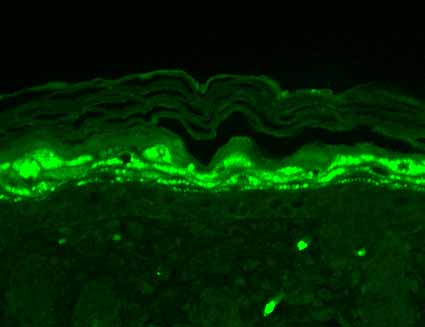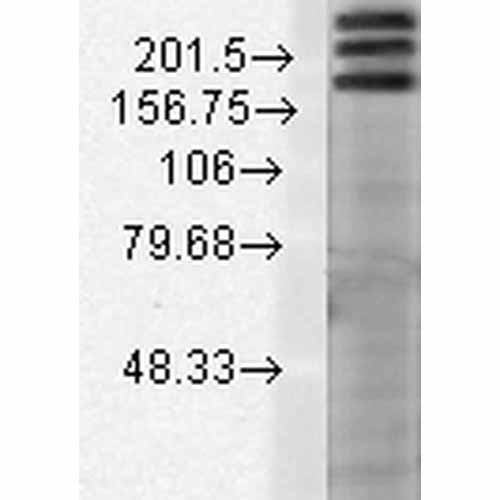SHANK1 Antibody
SHANK1 Antibody, Clone S22-21
- SPECIFICATION
- CITATIONS
- PROTOCOLS
- BACKGROUND

Application
| WB, IHC |
|---|---|
| Primary Accession | Q9WV48 |
| Other Accession | NP_113939.2 |
| Host | Mouse |
| Isotype | IgG1 |
| Reactivity | Human, Mouse, Rat |
| Clonality | Monoclonal |
| Description | Mouse Anti-Rat SHANK1 Monoclonal IgG1 |
| Target/Specificity | Detects ~190-220 kDa (alternative splice variants). No cross-reactivity against Shank2 or Shank3. |
| Other Names | GKAP/SAPAP interacting protein Antibody, OTTHUMP00000174437 Antibody, SH3 and multiple ankyrin repeat domains 1 Antibody, SH3 and multiple ankyrin repeat domains protein 1 Antibody, SH3/ankyrin domain gene 1 Antibody, SHAN1_HUMAN Antibody, SHANK 1 Antibody, Shank1 Antibody, Shank1a Antibody, Somatostatin receptor interacting protein Antibody, Somatostatin receptor-interacting protein Antibody, SPANK 1 Antibody, SPANK1 Antibody, SSTR interacting protein Antibody, SSTR-interacting protein Antibody, SSTRIP Antibody, Synamon Antibody |
| Clone Names | S22-21 |
| Immunogen | Fusion protein amino acids 469-691 (SH3/PDZ domains) of rat Shank1 |
| Purification | Protein G Purified |
| Storage | -20ºC |
| Storage Buffer | PBS pH7.4, 50% glycerol, 0.09% sodium azide |
| Shipping Temperature | Blue Ice or 4ºC |
| Certificate of Analysis | 1 µg/ml of SMC-329 was sufficient for detection of Shank1 in 10 µg of rat brain lysate by colorimetric immunoblot analysis using Goat anti-mouse IgG:HRP as the secondary antibody. |
| Cellular Localization | Cytoplasm | Cell Junction | Synapse | Postsynaptic Cell Membrane | Postsynaptic Density |

Thousands of laboratories across the world have published research that depended on the performance of antibodies from Abcepta to advance their research. Check out links to articles that cite our products in major peer-reviewed journals, organized by research category.
info@abcepta.com, and receive a free "I Love Antibodies" mug.
Provided below are standard protocols that you may find useful for product applications.
Background
Shank proteins make up a family of scaffold proteins identified through their interaction with a variety of membrane and cytoplasmic proteins (1). Shank proteins at postsynaptic sites of excitatory synapses play roles in signal transmission into the postsynaptic neuron. Studies suggest that Shank2 is expressed in the neurons of the developing retina, and could play a role in the neuronal differentiation of the developing retina (2). Other recent studies suggest that the disruption of glutamate receptors at the Shank postsynaptic platform could contribute to the destruction of the postsynaptic density, which underlies the synaptic dysfunction and loss in Alzheimer’s disease (3).
References
1. Sheng M., and Kim E. (2000) Journal of Cell Science. 113: 1851-1856.
2. Kim J.H., et al. (2009) Exp Mol Med. 41(4): 236-242.
3. Gong Y., et al. (2009) Brain Res. 1292: 191-198.
If you have used an Abcepta product and would like to share how it has performed, please click on the "Submit Review" button and provide the requested information. Our staff will examine and post your review and contact you if needed.
If you have any additional inquiries please email technical services at tech@abcepta.com.













 Foundational characteristics of cancer include proliferation, angiogenesis, migration, evasion of apoptosis, and cellular immortality. Find key markers for these cellular processes and antibodies to detect them.
Foundational characteristics of cancer include proliferation, angiogenesis, migration, evasion of apoptosis, and cellular immortality. Find key markers for these cellular processes and antibodies to detect them. The SUMOplot™ Analysis Program predicts and scores sumoylation sites in your protein. SUMOylation is a post-translational modification involved in various cellular processes, such as nuclear-cytosolic transport, transcriptional regulation, apoptosis, protein stability, response to stress, and progression through the cell cycle.
The SUMOplot™ Analysis Program predicts and scores sumoylation sites in your protein. SUMOylation is a post-translational modification involved in various cellular processes, such as nuclear-cytosolic transport, transcriptional regulation, apoptosis, protein stability, response to stress, and progression through the cell cycle. The Autophagy Receptor Motif Plotter predicts and scores autophagy receptor binding sites in your protein. Identifying proteins connected to this pathway is critical to understanding the role of autophagy in physiological as well as pathological processes such as development, differentiation, neurodegenerative diseases, stress, infection, and cancer.
The Autophagy Receptor Motif Plotter predicts and scores autophagy receptor binding sites in your protein. Identifying proteins connected to this pathway is critical to understanding the role of autophagy in physiological as well as pathological processes such as development, differentiation, neurodegenerative diseases, stress, infection, and cancer.



